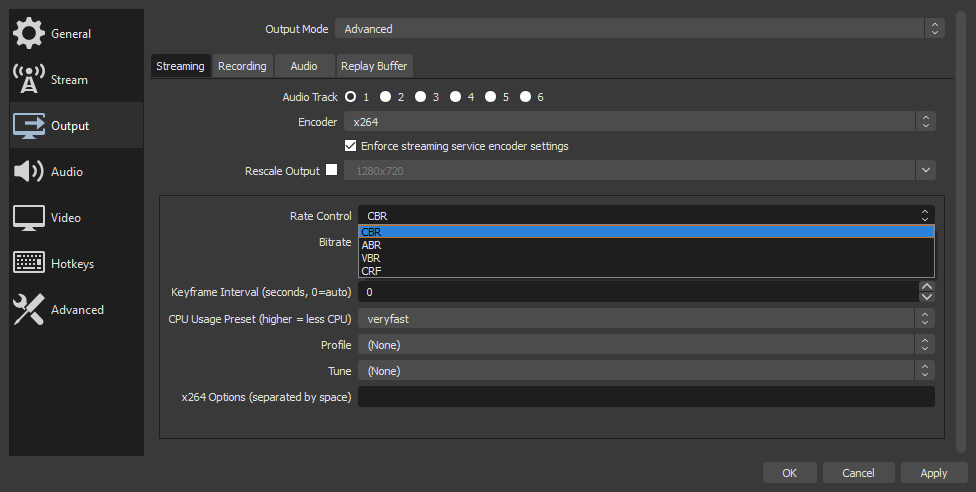Constant Freezing When Streaming Obs Good Upload

Using the right 'Rate Control' in OBS for streaming or recording
Don't know your CBRs from your CQPs? You volition soon!
Before your raw video can exist sent from OBS to a streaming platform (or recorded to your difficult drive), it offset needs to be downscaled and converted into a usable format. During that process, the particular is removed to compress the video size downwardly, which is where Rate Control comes in.
Choosing the right Charge per unit Command will have a massive touch on on the quality of your video, and then knowing which is the right for your content is vital.

To get started, open OBS and then click Settings, then Output, and change the Output Mode dropdown bill of fare from Simple to Advanced — this will allow you to manually select your Rate Control. The Encoder yous choose will impact which Rate Controls are bachelor to y'all, such as ABR which tin merely exist used when x264 is your Encoder.
As a general dominion, if yous have an Nvidia graphics card you tin can (and should) choose NVENC, if yous have an AMD graphics carte and a mid-range CPU you should choose AMF, and if you have a fast CPU, like an AMD Ryzen nine or an Intel i9, you lot should cull x264.
With that out of the mode, hither are your options, when to employ them, and fifty-fifty a couple to avert!
Before we brainstorm: Understanding bitrates
Your Charge per unit Command is tied to your video bitrate, and so if you need a refresher on what bitrate y'all should be using check out our guide here!
CBR (Constant Bitrate)
This is the standard bitrate to use for streamers. Permit's say you lot've set up your video bitrate to 3000 Kbps for your next stream, using CBR means your stream will ever be at 3000 Kbps, even when less could be used, such as a night game that lacks detail.
The reason this is practiced is when action shifts from say an all-black screen to a fast-moving prototype, the bitrate beingness constant ways the encoder will transition quickly and won't have to 'take hold of up'. Also, CBR sends data in a by and large predictable fashion, pregnant it is less likely to encounter problems when traveling to its endpoint than more than erratic Rate Controls.
For 99% of streamers, CBR is the way to get, only there are border cases where other Charge per unit Control options might be better, then read on!

ABR (Adaptive Bitrate)
x264 only
The middle footing between CBR and VBR (which we'll hash out beneath) is ABR. This option allows more than circuitous parts of your stream to use more than bits and less detailed parts use less. It's a niggling complicated, and not actually used past streamers, but this is the bitrate most popular with OTT (over-the-top) video delivery. So, if you're running a 24-hour channel, this might be a proficient option, otherwise, stick with either CBR or VBR.
CQP (Abiding Quantization Parameter)
NVENC and AMF only
If you lot need to record video at ultra-high quality, CQP is the manner to go. When switching to CQP the bitrate control is removed and replaced with CQ Level from 0 to 30. The lower the number, the higher the quality, but if you're recording at annihilation less than CQ Level 14 yous're probably wasting your time as it's essentially lossless video at that point.
Recording with CQP will fill up your hard drive pretty quick, and truthfully you lot may exist meliorate off with VBR (encounter below), but if you need ALL the detail of a video (like when doing graphics comparison videos) CQP might be for y'all. But don't stream with it! None of the platforms recommended information technology, and it wasn't designed for streaming anyway.
VBR (Variable Bitrate)
While CBR provides a constant video output of the same quality, VBR will adjust the bitrate upward and downward depending on what is needed. Permit'southward say your video bitrate is gear up to 3000 Kbps, you might come across it dip to 1500 Kbps when there'southward not much action on screen, then go support to 3000 Kbps when action resumes.
Sounds skillful, correct? Well, that ramp up tin take a 2d or more, and in that time your stream will look blocky equally it tries to 'catch upward'. In add-on to that (and as mentioned before), because of how information is routed online (from servers to routers then on) the unpredictable nature of VBR can introduce issues that the predictable nature of CBR avoids.
That said, VBR can be useful when recording gameplay at higher bitrates (such as 100,000 Kbps) when you're not looking for the ultra-detailed results that you'll get with CQP. Information technology'south difficult to recommend VBR for live content, but when CQP feels like overkill, become with VBR. Your hard bulldoze volition give thanks y'all.
CRF (Constant Rate Cistron)
x264 only
Similar to how CQP gives you a range of 0 to 30, with the lower numbers being improve quality, CRF ranges from 0 to 51, with around 17 to 24 being considered 'good quality'. Approximately every 6 points will double your file size, and as y'all can imagine, subtracting 6 will halve it.
This is your high-quality recording pick when CQP is unavailable — but simply like CQP, it's for recording, not streaming.
Lossless
NVENC and AMF but
Don't employ Lossless. That might sound foreign, but let's face up it, you lot're most probable going to have to edit your video on your PC, and the huge files made past Lossless will make that a nightmare. Plus, when you upload your video to YouTube or wherever it'll get crushed dorsum down to size past their encoder.
Also, Lossless isn't very reliable and does crash OBS now and then. It's here for people experimenting with high-end video and edge cases, simply for the majority of users, Lossless is all-time avoided.
Permit'southward proceed this simple
If yous're streaming, use CBR as every platform recommends it and it's a reliable class of Rate Control. If yous're recording and demand to be high quality, utilise CQP if the file size is no consequence, or VBR if you want to keep file size more reasonable.
Source: https://blog.mobcrush.com/using-the-right-rate-control-in-obs-for-streaming-or-recording-4737e22895ed